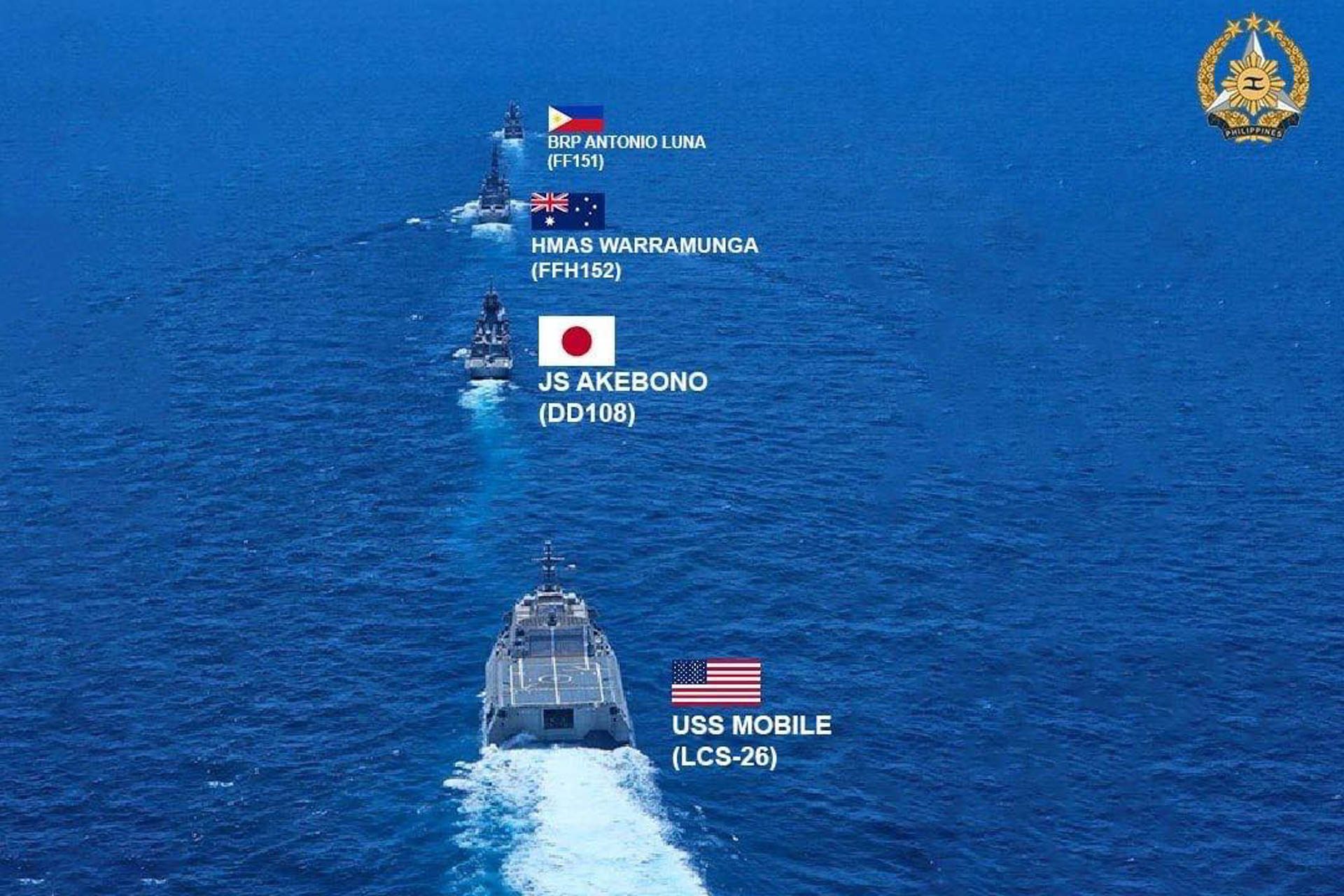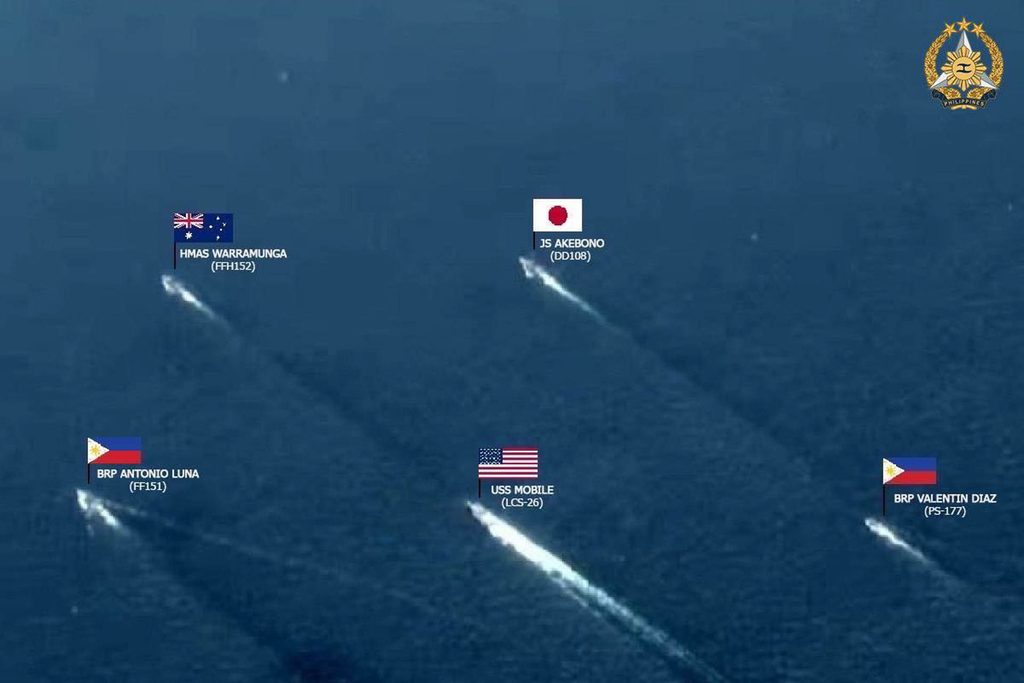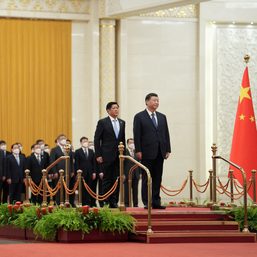SUMMARY
This is AI generated summarization, which may have errors. For context, always refer to the full article.

PALAWAN, Philippines – Hello from Manila, but I write this to you on board the BRP Cabra, fresh off a joint Philippine Coast Guard (PCG) and Bureau of Fisheries and Aquatic Resources (BFAR) mission to Recto Bank, where we covered Filipino fisherfolk in installing payaos, or fish aggregating devices, in Rozul Reef.
The mission, thankfully, went mostly unimpeded had it not been for the strong currents that made it difficult for 20 of the 25 fishing vessels to arrive at the meeting point on time. It was the fisherfolk themselves, alongside the BFAR and the PCG, who installed all 10 payaos from late morning until the evening.
All of this happened under the very watchful and harassing eye of two China Coast Guard (CCG) vessels that began tailing the BFAR’s BRP Lapu-Lapu in the wee hours of the morning on April 4.
Throughout the nearly 12-hour mission to Rozul Reef, Chinese ships circled and tailed the BFAR and PCG vessels, sailed close to the much, much smaller Filipino fishing bangkas, and at several points late in the day, performed dangerous maneuvers on the BRP Lapu-Lapu and the BRP Cabra.
Early in the morning, while we waited for the rest of the fisherfolk to finally arrive in Rozul Reef, came a quick but tense warning: “Prepare for water cannon.”

I was standing on the deck of the BRP Lapu-Lapu, close to its bow, when the BRP Lapu-Lapu’s watchers, personnel of the PCG, saw Chinese personnel position themself in front of the (almost comically) red water cannon of the ship.
Journalists who join PCG (and BFAR, in this case) missions to the West Philippine Sea are reminded to be on alert at all times (a given) and to immediately seek shelter indoors should a water cannon attack seem imminent.
Thankfully, no water cannons were launched that day.
That we’re thankful for the bare minimum betrays just how tense things have become in the West Philippine Sea.
David at sea
Rozul Reef, among the southernmost features of Recto Bank, is located around 141 nautical miles off the coast of Palawan. Further south is Ayungin Shoal or Second Thomas Shoal, and much further up north is Bajo de Masinloc, flashpoints for tensions between Manila and Beijing in these waters.
In Ayungin and Bajo de Masinloc, the CCG has not been shy to use its water cannons, often against Philippine ships that are much smaller.
PCG spokesperson for the West Philippine Sea, Commodore Jay Tarriela, said the CCG’s liberal use of water cannons is, in a way, because the Philippines’ “transparency initiative” is affecting Beijing.
“We are the David, they are the Goliath. They have incurred so much reputational costs with that kind of narrative…. But this time around, especially after what they did with the last ROREs… I think they have already understood the fact that the transparency strategy has gained so much headway on the positive side for the Philippine government. And what worries them is that what if other countries among the claimant states that are also experiencing their harassment… would also be doing the same thing,” he told media who joined the Rozul Reef mission on April 6.
“So they need to increase the level of provocation to make it appear that the Goliath is not just an ordinary Goliath who is really willing to use brute force to threaten David…. Our assumption is that that’s the only thing that they’re doing. It’s only on the level of threat. But as to the actual use of force to prevent the Philippine government or any other claimant states in the entire South China Sea, that is something that I think and I’d like to believe China will still hesitate to carry out,” he added.

Countermeasure part 1?
A week after President Ferdinand Marcos Jr. announced a package of “countermeasures” against China, the Philippines, its only treaty-ally the United States, and strategic partners Japan and Australia announced the first ever quadrilateral joint drill in… where else, but the West Philippine Sea.
On Sunday, April 7, the “Multilateral Maritime Cooperative Activity,” which spanned the areas of operation of the Western Command and the Northern Luzon Command (that’s from Palawan all the way up north), took place with “no untoward incident,” according to the Armed Forces of the Philippines (AFP).
Earlier on Sunday, the Chinese military’s Southern Theater Command announced a “joint naval and air strategic patrol” in the South China Sea as the Philippines, US, Japan, and Australia patrolled the West Philippine Sea together.
“All military activities disrupting the South China Sea situation and creating buzzes are under control,” claimed China’s Southern Theater Command.
Photo and video from the joint exercise were a sight to behold.


Surely, the sight of the Philippines’ BRP Antonio Luna leading Australia’s HMAS Warramunga, Japan’s JS Akebono, and the US’ USS Mobile in an Officer of the Watch maneuver exercise, is unlikely to delight our Chinese neighbors, who claim practically the entire South China Sea.
The AFP event waxed poetic in its caption: “In the tranquil blue of the West Philippine Sea, a quartet of commitment cruises forward: Vessels from the Philippines, Australia, Japan, and the United States. Their steady wake in these waters is a silent yet resounding message – the upholding of freedom of navigation, a principle enshrined in international law, is a collective pursuit. These maritime cooperative activities are more than mere movements; they are resolute strides towards a future of peace and adherence to the rule of law.”
Joint drills make for great visuals. Beyond this, they also ensure that the militaries of the Philippines, the US, Japan, and Australia (as well as their top officials) are familiar with each other, and are able to efficiently work together out at sea.
It’s an excellent prelude to the upcoming leaders’ trilateral in Washington DC between US President Joe Biden, Japanese Prime Minister Kishida Fumio, and Marcos on April 11.
The Financial Times reported that Biden will “warn China about its increasingly aggressive activity in the South China Sea,” citing senior US officials. In particular, Biden will be expressing “serious concern about the situation around the Second Thomas Shoal,” or Ayungin Shoal, where resupply missions are turning more violent and more dangerous for Filipino sailors. – Rappler.com
Add a comment
How does this make you feel?







There are no comments yet. Add your comment to start the conversation.